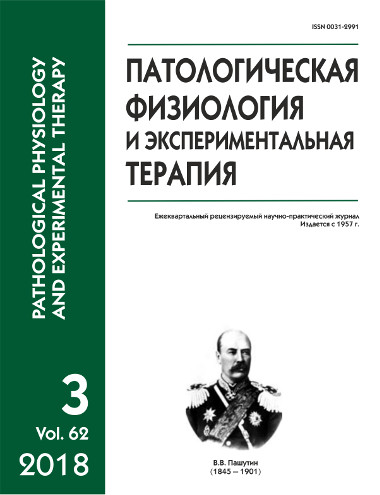Effect of estradiol on P-glycoprotein functional activity in experiment
Abstract
The aim of the study was to evaluate the P-glycoprotein functional activity after ovariectomy followed by estradiol treatment. Methods. The study was conducted on 23 Chinchilla rabbits weighing 4300—4700 g. Group 1 underwent a sham surgery; Group 2 was ovariectomized; Groups 3 and 4 underwent ovariectomy followed by oral estradiol treatment (0.5 mg and 2 mg, respectively). On day 7 prior to the experiment and on days 14, 28, and 42 after the surgery, P-glycoprotein functional activity was determined in rabbits of all groups by measuring fexofenadine pharmacokinetics using HPLC and serum concentrations of sex hormones (estradiol, progesterone, testosterone) using the radio immune method. Results. Ovariectomy decreased the P-glycoprotein functional activity as evident from changes in the fexofenadine pharmacokinetics — increased Cₘₐₓ and AUC₀₋ₜ and decreased Cl. The estradiol administration at a dose of 0.5 mg for 28 days after ovariectomy increased the P-glycoprotein functional activity compared to the ovariectomy group; however, the P-glycoprotein functional activity remained lower than at baseline. The estradiol treatment at a dose of 2 mg after ovariectomy increased the P-glycoprotein functional activity compared to the ovariectomy group and restored the P-glycoprotein functional activity to the value for intact animals. No correlations were found between the maintenance of estradiol content and the P-glycoprotein functional activity. Conclusion. The treatment with low-dose estradiol stimulated Pgp at the level of a whole body but was not sufficient to restore its original activity. Perhaps, for a complete recovery of the Pgp functional activity to the baseline level, additional administration of progesterone is required. When estradiol was administered at a high dose the Pgp activity increased to the baseline, preoperative level even without normalization of the progesterone content.
Downloads
References
2. Gottesman M.M. Mechanisms of cancer drug resistance. Annu. Rev. Med. 2002; 53: 615-27. 85
3. Kim W.Y., Benet L.Z. P-glycoprotein (P-gp/MDR1)-Mediated Efflux of Sex-Steroid Hormones and Modulation of P-gp Expression In Vitro. Pharmac. Res. 2004; 21(7): 1284-93.
4. Coles L.D., Lee I.J., Voulalas P.J., Eddington N.D. Estradiol and progesterone-mediated regulation of P-gp in P-gp overexpressing cells (NCI-ADR-RES) and placental cells (JAR). Mol. Pharm. 2009; 6 (6): 1816-25.
5. Mutoh K., Tsukahara S., Mitsuhashi J., Katayama K., Sugimoto Y. Estrogen-mediated post transcriptional down-regulation of P-glycoprotein in MDR1-transduced human breast cancer cells. Cancer Sci. 2006; 97(11): 1198-204.
6. Haines C., James A., Sahota D., Chen Z.Y., Panesar N., Tomlinson B., Chow L., Benzie I., Husband A. Comparison between phytoestrogens and estradiol in the prevention of atheroma in ovariectomized cholesterol-fed rabbits. Climacteric. 2006; 9: 430-6.
7. Yakusheva E.N., Chernykh I.V., Shchulkin A.V., Gatsanoga M.V. Methods of identification of drugs as P-glycoprotein substrates. Rossiyskiy mediko-biologicheskiy vestnik imeni akademika I.P. Pavlova. 2015; 3: 49-53. (in Russian)
8. Gatsanoga M.V., Chernykh I.V., Shchulkin A.V., Yakusheva E.N., Popova N.M. The method of assessment of drugs belonging to the substrates of P-glycoprotein on female rabbits. Nauka molodykh (Eruditio juvenium). 2016; 3: 5-10. (in Russian)
9. Karkishchenko N.N., Horon’ko V.V., Sergeeva S.A., Karkishchenko V.N. Pharmacokinetics [Farmakokinetika]. Rostov-na-Donu: Feniks, 2001. (in Russian)
10. Yakusheva E.N., Chernyh I.V., Shchulkin A.V., Kotlyarova A.A., Nikiforov A.A. Sex differences of P-glycoprotein functional activity and expression in rabbits. Rossiyskiy fiziologicheskiy zhurnal imeni I.M. Sechenova. 2014; 10 (8): 944-52. (in Russian)
11. Bauer B., Hartz A.M.S., Fricker G., Miller D.S. Modulation of P-Glycoprotein transport function at the blood-brain barrier. Exp. Biol. Med. 2000; 230 (2): 118-27.
12. Lee S.D., Osei-Twum J., Wasan K.M. Dose-dependent targeted suppression of P-glycoprotein expression and function in Caco-2 cells. Mol. Pharm. 2013; 10 (6): 2323-30.
13. Arias A., Rigalli J.P., Villanueva S.S., Ruiz M.L., Luquita M.G., Perdomo V.G. et al. Regulation of expression and activity of multidrug resistance proteins MRP2 and MDR1 by estrogenic compounds in Caco-2 cells. Role in prevention of xenobiotic-induced cytotoxicity. Toxicology. 2014; 320: 46-55.
14. Miao Z.H., Ding J. Transcription factor c-Jun activation represses mdr-1 gene expression. Cancer Res. 2003; 63 (15): 4527-32.
15. Geick A., Eichelbaum M., Burk O. Nuclear Receptor Response Elements Mediate Induction of Intestinal MDR1 by Rifampin. J. Biolog. Chemistry. 2001; 276: 14 581-87.






